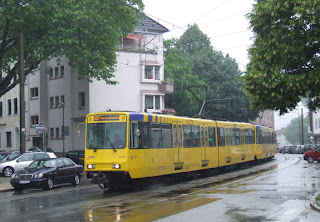The city of Essen is one of the largest in Germany's "Ruhrgebiet" (Ruhr area). Home to over half a million people, the city is twinned with several others around the world including Sunderland, the subject of my previous post.
Public transport in Essen is co-ordinated by Essener Verkehrs-AG (EVAG). I paid Essen a brief visit in June 2013, on a particularly wet morning!
 On the streets of the city centre, buses are the only visible element of Essen's public transport system. The bus network converges on the main railway station, providing an easy interchange onto local, regional and inter-city train services.
On the streets of the city centre, buses are the only visible element of Essen's public transport system. The bus network converges on the main railway station, providing an easy interchange onto local, regional and inter-city train services.
Many of the buses I saw in Essen were three-door, articulated single-deckers.
 Buses on some routes are fitted with guidewheels, a sign that they operate on guided busway. In the time I had available to me, I didn't get to explore the guided sections of route which lie outside the city centre.
Buses on some routes are fitted with guidewheels, a sign that they operate on guided busway. In the time I had available to me, I didn't get to explore the guided sections of route which lie outside the city centre.
Essen's guided bus system is covered in greater detail by the City Transport website.
 As well as articulated buses, standard single-deckers with two sets of doors operate on a couple of routes into the city centre.
As well as articulated buses, standard single-deckers with two sets of doors operate on a couple of routes into the city centre.
Although buses on the EVAG network wear a common livery of yellow, they are provided by a number of operators. On this vehicle, the operator has added its own web address towards the rear.
I noted yellow articulated buses operating on route SB15.
 Routes SB16 and SB19 were being operated under the DB (DeutscheBahn) Rheinlandbus brand (website in German only). A mix of standard, three-axle and articulated buses was in use.
Routes SB16 and SB19 were being operated under the DB (DeutscheBahn) Rheinlandbus brand (website in German only). A mix of standard, three-axle and articulated buses was in use.
Some wore DeutscheBahn red livery.
 Others wore a red, white and green colour scheme of the bus company which operates them on DeutscheBahn's behalf.
Others wore a red, white and green colour scheme of the bus company which operates them on DeutscheBahn's behalf. There are double-deck vehicles in Essen, but these are confined to sightseeing tours. They have retractable roofs so, in better weather, can operate as open-toppers.
There are double-deck vehicles in Essen, but these are confined to sightseeing tours. They have retractable roofs so, in better weather, can operate as open-toppers.Information about the Essen sightseeing tour (in German only) can be found here.
 Although you will only see buses on the city centre streets, Essen also has a tram system as well as an underground (U-Bahn). These run in tunnel beneath the city centre but emerge above ground in the inner suburbs.
Although you will only see buses on the city centre streets, Essen also has a tram system as well as an underground (U-Bahn). These run in tunnel beneath the city centre but emerge above ground in the inner suburbs. As well as the trams, Essen has an U-Bahn (underground railway) comprising three lines. This also operates above ground over certain stretches.
As well as the trams, Essen has an U-Bahn (underground railway) comprising three lines. This also operates above ground over certain stretches.Part of line U18 operates along the central reservation of the autobahn.
 Whereas the trams have low entrances (with steps inside), the U-Bahn vehicles have high entry and therefore need higher platforms.
Whereas the trams have low entrances (with steps inside), the U-Bahn vehicles have high entry and therefore need higher platforms.At this stop, there is a terminus loop for the trams. Look closely at the tracks and you may spot something. The U-Bahn uses standard gauge track (1435mm) whereas the tram track gauge is 1 metre.
These units originally operated on London's Docklands Light Railway, where they were driven automatically. They were withdrawn prematurely, as they became unsuitable for the growing network in London's Docklands. They have been converted to manual driving (and overhead electrification) for use in Essen.
The fare system in Essen is prescribed by the Verkehrsverbund Rhein-Ruhr (VRR), which is the regional transport authority covering the Rhine-Ruhr area. As is common practice in most of the cities I have visited outside the UK, a single tariff applies to bus, tram and suburban rail services. Single journey tickets permit interchange provided the journey is completed within a set time limit.












No comments:
Post a Comment